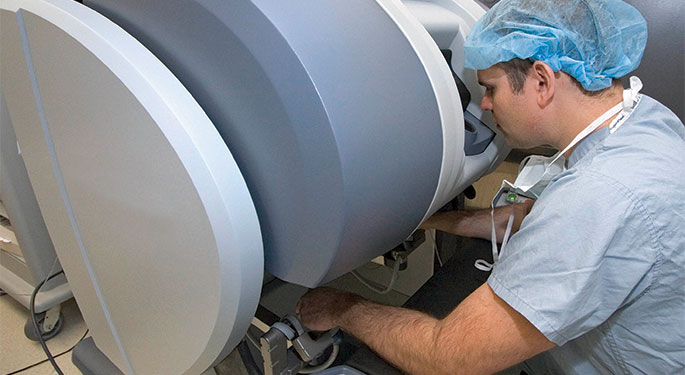Minimally Invasive Surgery for Kidney Cancer

Kidney cancer is the eighth most common type of cancer in the United States. Fortunately, if treated early, the prognosis for recovery is excellent. The five-year survival rate for stage 1 cancer is more than 90 percent. We can remove the entire kidney (nephrectomy) or just the tumor (partial nephrectomy) using minimally invasive surgical techniques. The advantage to removing just the tumor is that you retain kidney function.
At Mount Sinai, we have performed thousands of full and partial nephrectomies using minimally invasive robotic and laparoscopic techniques. The potential benefits of these techniques are faster recovery, minimal or no blood loss, and a reduction in side effects. Most of our robotic surgery patients are able to go home the day after surgery.
Minimally invasive robotic surgery enables us to remove all or part of the kidney with greater precision than traditional laparoscopic surgery (performed using handheld videoscopic equipment and instruments). This approach is not an option for all patients; it depends on the size, location, and aggressiveness of the tumor as well as your medical profile and history, expectations, and preferences. As a pioneer in the use of minimally invasive robotic surgery for kidney cancer, we are one of the few medical centers in the United States to offer this procedure.
Laparoscopy is an effective approach for a complete (radical) or partial removal of the kidney. We insert instrumentation through small incisions in the abdomen in order to view and remove the kidney tumor or entire kidney. Laparoscopic outcomes are comparable to open surgery and allow for less postoperative pain, a shorter hospital stay, and quicker recovery.
Minimally Invasive Therapies
We also use a variety of non-surgically minimally invasive approaches to treating kidney cancer, when appropriate for the individual patient.
Percutaneous and laparoscopic cryoablation are two separate procedures that involve freezing the tumor without making an incision. We sometimes perform these procedures in partnership with specialists from Mount Sinai’s Division of Interventional Radiology, one of the country’s most advanced facilities for image-guided procedures. We perform percutaneous procedures by going directly through the skin to the kidney. A laparoscopic approach uses small incisions in the abdomen. Either way, we send cold gases through hollow tubes into the kidney to destroy the tumor by freezing.
We use percutaneous cryoablation when surgery would be too risky or if you have very small tumors (less than 4cm) located in a favorable spot. If the tumors are very small but are in difficult anatomic locations, we may be able to use a laparoscopic approach.
Percutaneous radio frequency ablation involves using specially designed, image-guided needles that we insert through the skin to the kidney. We use these needles to deliver radio waves that shrink the kidney tumor by heat.
Microwave ablation destroys the tumor using controlled heat at higher temperatures than we can do using radio waves. Higher heat can destroy the tumor more effectively than RFA.
Arterial embolization involves sending solid particles or a special liquid through the renal artery to block the flow of blood into the tumor, essentially starving it of oxygen. As a result, the tumor shrinks or is destroyed. We occasionally embolize tumors if we think you may not be able to tolerate surgery or ablation. We can also use this technique to stop bleeding before performing either surgery or ablation.